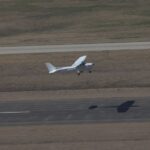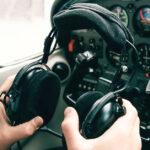With the hot weather disappearing in most parts of the country, pilots are thinking about the upcoming winter weather and the challenges that will affect how we plan and execute our flights. While cold weather and icing conditions quickly pop into the minds of most pilots when thinking about winter flying, we also need to consider the preparations that should be made to ensure that our aircraft are mechanically ready for these challenges as well.
CLIMATE CONTROL
Multi-engine aircraft typically use a combustion heater to provide cabin heat during flight, while most single engine trainers rely on heat generated by airflow over the exhaust system. Combustion heaters rely on combustion of a fuel source, typically aviation gasoline (Avgas) to generate heat, which is then transferred to the aircraft’s cabin. When operating your aircraft’s combustion heater, it’s important to follow the checklist and the manufacturers’ procedures (as they may vary from manufacturer to manufacturer).
Single engine aircraft usually have a shroud around the muffler that traps and warms air by using the heat from the exhaust system during engine operation. This air is then directed into the cabin for climate control. While this system is much simpler than the combustion heater, and doesn’t use any fuel or ignition systems, any cracks in the muffler can send carbon monoxide into the cabin. This is why most aircraft have carbon monoxide detectors installed.
Regardless of the type of heating system that you are using, it is crucial that you verify that it has been inspected and tested, and that you’re up-to-date with all scheduled maintenance.
OIL
Selecting the proper oil for the season will reduce the wear on your engine and help it to operate well to full TBO (time between overhaul). As temperatures increase, oil decreases in viscosity (thickness). The opposite is true when temperatures decrease. This is why we use lower viscosity oil (W65) in the colder winter months at our northern training locations and a thicker oil viscosity (W80) in some of our warmer locations during the same time of year. In the heat of the summer, we will be using W100 in the same engines.
Did you know that the “W” (W100, W80, etc.) doesn’t mean “weight” when identifying oil? This is a designation which stands for “winter.” It describes the viscosity of the oil at the cold end of its operating range.
Multi-viscosity oils are designed to work through a wider temperature range (e.g. 20W50). The 20W50 means that this oil will act as if it had a viscosity rating of 20 in colder temperatures and a viscosity rating of 50 in warmer temperatures. Be sure to check the manufacturer’s recommended temperature range or ask a mechanic before using an oil in your aircraft.
Many aircraft like the Cessna 172 have winterization kits available that reduce the amount of airflow over the engine to help keep the engine operating within the recommended temperature range. You should find out if the aircraft that you are flying has a winterization kit installed, so you will understand what the effects of that kit are on your engine. If you do have a winterization kit installed on your aircraft, you also need to understand its limitations. An example would be taking off in the Northeast with a winterization kit installed when it is 5°F, and your destination is Florida where it is 70°F. The limitation on the winterization kit says that it should not be used at temperatures over 20°F. Do you remove it before your flight? Do you remove it en route? You should speak with your mechanic to make the proper decision.
Before every flight, a thorough pre-flight inspection is crucial, especially in cold weather. Cold temperatures can affect various components of an aircraft, making it essential to give them extra attention.
Batteries: Cold weather can drain aircraft batteries more quickly. Make sure the battery is fully charged and that it can provide the necessary power for engine starts and avionics operation.
Tires and Landing Gear: Cold temperatures can reduce tire and landing gear oleo strut pressures, affecting the aircraft’s handling and landing performance. Verify proper tire pressure and landing gear strut extension before flight.
Crankcase Breather Tubes: The crankcase of general aviation piston engines is vented to the outside air to help equalize pressure inside the engine as the aircraft climbs and descends during flight. As the engine cools after a flight, condensation can form in this tube and ice over, causing a blockage that could potentially cause a build up of pressure that can cause oil-seal failure or engine shut down in extreme cases. The end of the crankcase breather should be inspected for icing where it extends below the cowling before every flight in freezing temperatures.
Engine Preheating: Consider using an engine preheater to warm up the engine and prevent cold-soaked components, which can cause difficulties during engine start. Refer to the manufacturer’s temperature recommendations for when to preheat.
Hangar Storage: If possible, store your aircraft in a heated hangar during extremely cold weather. This not only protects the aircraft from ice and snow accumulation but also prevents cold-soaked components which can make maintenance and pre-flight inspections more challenging.
Fuel Management: Cold temperatures can cause fuel to contract, leading to water condensation in the tanks. To prevent water contamination in your fuel system, regularly check and drain fuel sumps to remove any water that may have accumulated.
A proactive approach to pre-flight inspections, de-icing, engine and oil management, hangar storage, and fuel management can help mitigate the challenges posed by cold weather. By following these guidelines and staying informed about your specific aircraft’s requirements, you can continue to enjoy flying during the winter months.










